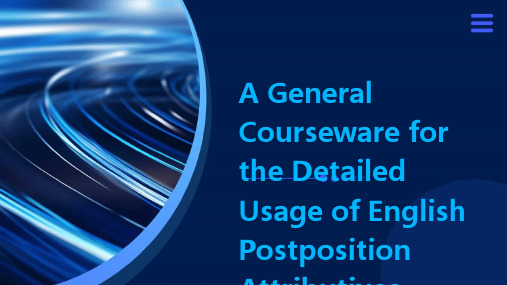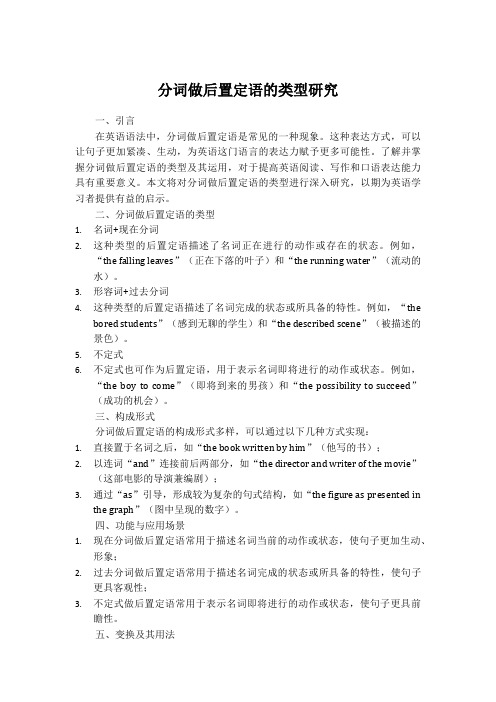英语后置定语语法归纳
高中英语语法漫谈六 后置定语

六、作后置定语用的形容词短语许多形容词可以与某些词(组)或结构搭配构成形容词短语。
当这些短语在句子中作名词的修饰语时, 应该后置, 其语法功能相当于一个省略形式的定语从句(限制性或非限制性均可), 也就是说后置的形容词短语相当于省去"which/who/that + be" 之后保留下来的表语。
这种形容词短语的构成方式大致可以分为以下几种:一、两个或两个以上的形容词可以在一起由and或but连接而构成形容词短语。
这种短语作后置定语时, 一般修饰具有泛指意义的名词。
如:He is a man rude but henpecked.他是一个粗暴而惧内的男人。
children innocent, lively and lovely天真而又活泼可爱的孩子(注: 此类形容词短语亦可作前置定语)二、有些形容词常与某些介词短语搭配, 作后置定语。
如:The leaders present at the meeting tota11ed eight.出席会议的领导共有八人。
This is a subject worthy of careful study.这是一个值得仔细研究的问题。
另外, 有些形容词(表语形容词除外) 与介词搭配时, 我们还可以把它和其后的介词拆开, 即将形容词置于名词之前, 将介词短语置于名词之后。
如:a question different from this one = a different question from this one 一个与此不同的问题三、少数形容词后面可以直接跟逻辑宾语, 用以构成后置定语来修饰名词。
如:She owns a diamond worth four thousand francs 她有一颗价值四千法郎的钻石。
a boy afraid (tha t) he can’t pass the exam 一个怕这次考试不能及格的男孩a student confident (that) he will be able to pass the exam一个对通过考试很有自信心的学生*有的语法书上认为形容词后面的that从句是状语从句, 有的认为是宾语从句。
英语 后置定语

英语后置定语在英语中,后置定语是修饰名词的语法结构,它们通常放在被修饰的名词之后。
后置定语可以是形容词、副词、介词短语、不定式短语、过去分词短语、现在分词短语或限定性从句。
以下是每种类型的后置定语的详细解释。
1. 形容词作后置定语形容词作后置定语时,一般放在被修饰的名词之后。
例如,“the boy beautiful”中,“beautiful”是形容词后置定语,修饰“boy”。
2. 副词作后置定语副词也可以作为后置定语,放在被修饰的名词之后,用来修饰或限定名词。
例如,“the car there”中,“there”是副词后置定语,修饰“car”。
3. 介词短语作后置定语介词短语通常用作后置定语,放在被修饰的名词之后,以表示与该名词相关的位置、时间、方式等。
例如,“the book on the table”中,“on the table”是介词短语后置定语,修饰“book”。
4. 不定式短语作后置定语不定式短语也可以用作后置定语,放在被修饰的名词之后,用来表示名词的动作或状态。
例如,“the decision to go”中,“to go”是不定式短语后置定语,修饰“decision”。
5. 过去分词短语作后置定语过去分词短语可以用作后置定语,放在被修饰的名词之后,表示被动关系或已经完成的状态。
例如,“the book written by him”中,“written by him”是过去分词短语后置定语,修饰“book”。
6. 现在分词短语作后置定语现在分词短语可以用作后置定语,放在被修饰的名词之后,表示主动关系或正在进行的状态。
例如,“the man talking to her”中,“talking to her”是现在分词短语后置定语,修饰“man”。
英语后置定语的详细用法

单个词做后置定语
02
Байду номын сангаас
(一)形容词做后置定语
2.英语中有些以a为词首的形容词做定语时,均放在被修饰语后面。如:alone, alike, afraid, , ashamed, awake 等 The girl asleep is my younger sister. He is the greatest writer alive.
我的句子:那个被Tom打的男孩是杨清。(beat)
named
written
3.动词不定式做后置定语: 与被修饰成分之间表示不同的语义关系: (1)表示动宾关系(2)表示主谓关系 (3)表示修饰关系 (4)表示同位关系
(1)表示动宾关系 被修饰的名词为动词不定式to do的直接宾语。 I have a lot of work to do today. He had a big family to support. I don’t have a house to live in . I don’t have a pen to write with. I don’t have a piece of paper to write on
He looked at the street full of cars(形容词短语)
我的句子:
副词做后置定语时一般表示时间、地点等. The weather here is very nice. The building around are modern .
(二)副词做后置定语
Is there anybody wounded? There is no money left . 我的句子:这儿的食物很美味。(副词) 我没有剩余的钱了。(过去分词)
英语中形容词作后置定语的十种情况

英语中形容词作后置定语的十种情况
1. 名词作主语的形容词后置。
例如:The movie is interesting.
2. 名词作宾语的形容词后置。
例如:I find the book boring.
3. 物主代词作宾语的形容词后置。
例如:He lost his key.
4. 数词作宾语的形容词后置。
例如:She has two dogs.
5. 不定代词作宾语的形容词后置。
例如:I saw something strange.
6. 感官动词(如see、hear、smell、feel等)后置的形容词。
例如:
I heard something strange.
7. 整体名词后置的形容词。
例如:His shirt is red.
8. 序数词后置的形容词。
例如:He is the first person to arrive.
9. 代词one或ones后置的形容词。
例如:I want the blue one.
10. 由两个或更多形容词组成的形容词短语后置。
例如:It was a long and tiring day.。
定语后置的7种类型复习 讲义-2023届高考英语一轮复习

定语后置一、形容词enough作定语,而着又是强调它所修饰的那个名词,或者它所修饰的名词起形容词作用且前面不加冠词时,通常要后置。
比如:I haven't time enough to do the work.我没有足够的时间做那件工作。
He hasn't man enough to admit his mistake.他没有勇于认错的大丈夫气概。
二、当定语是一个形容词,它所修饰的是由any-,every-,some-等跟-body,-one,-thing构成的复合代词时,通常后置。
比如:There is some-thing important in today's newspaper.今天的报纸上有条关键新闻。
He wanted to get someone reliable to help in this work.他想找个可靠的人帮忙做这项工作。
三、它所修饰的词前面有帮助以加强语气的the one等之类的词语时须后置。
定语由形容词表示,它所修饰的词是起名词作用的anywhere,somewhere等时,也须后置。
比如:This is the one thing needful.这是需要的东西。
Can you find anywhere quiet?你能找个清静的地区吗?He has been sent to somewhere particular.他被派到某个特定的地区去了。
四、定语由here,there,in,out,home,above,below,abroad,before,yesterday等副词充当时,往往要后置。
比如:He is on his way home.他在回家途中。
Can you tell me something about the social system there?你能给我讲讲那里的社会制度吗?It had been fine the day before.前一天的天气很好。
现在分词和过去分词作后置定语的句型

现在分词和过去分词作后置定语的句型
现在分词和过去分词作后置定语是英语语法中常用的结构,它们
常常被用来修饰名词,在句中起到非常重要的作用。
现在分词作后置定语时,通常表示的是与被修饰的名词一同发生
的动作或状态,例如:The children playing in the park are all very happy. 这个句子中,playing in the park作为后置定语修饰children,表示孩子们正在公园里玩耍。
过去分词作后置定语则通常表示的是被修饰的名词所承受的动作
或状态,例如:The book written by the famous author is very popular. 这个句子中,written by the famous author作为后置定语修饰book,表示这本书是由这个著名的作家所写的。
这种结构在实际应用中十分常见,我们可以在阅读时多留意这类
结构的运用,为我们提高英语阅读和写作能力带来很大的帮助。
同时,在学习过程中,我们还应该注意这两种结构的形式和用法,尤其是一些特殊的用法和注意事项。
比如,当这两种分词作为后置定
语修饰代词时,通常需要加上适当的介词,例如:The girl standing next to me is my sister. 这个句子中,standing next to me作为
后置定语修饰girl,表示这个女孩站在我旁边。
总之,现在分词和过去分词作后置定语是英语学习中不可忽略的部分,只有熟练掌握了这两种结构的形式和用法,才能更好地运用英语,提高我们的写作和交流能力。
英语后置定语的详细用法通用课件

Comparison with independent nominative structures
结构差异
01
独立主格结构具有独立的主谓关系和句法结构,而介词短语后
置修饰名词时没有独立的主谓关系和句法结构。
语义关系
02
独立主格结构表达完整的意义,而介词短语后置修饰名词时只
是对名词进行修饰,不能单独表达意义。
Precautions when using post attributives
Grammar accuracy
Postpositional attributives should be used correctly in grammar. They cannot be used as predicates or adverbs. For example, "The cat is in the house" is correct, but "The cat in the house is sleeping" is incorrect.
结构差异
介词短语后置修饰名词时,介词短语与名词之间没有句法 联系,而介词短语前置修饰名词时,介词短语与名词之间 存在句法上的联系。
语义关系
介词短语后置修饰名词时,介词短语与名词之间没有明确 的语义关系,而介词短语前置修饰名词时,介词短语与名 词之间存在语义关系。
句法功能
介词短语后置修饰名词只能充当修饰性定语,而介词短语 前置修饰名词可以充当修饰性定语和限制性定语。
The logical relationship between post attributive and modified noun
Noun modification
分词做后置定语的类型

分词做后置定语的类型研究一、引言在英语语法中,分词做后置定语是常见的一种现象。
这种表达方式,可以让句子更加紧凑、生动,为英语这门语言的表达力赋予更多可能性。
了解并掌握分词做后置定语的类型及其运用,对于提高英语阅读、写作和口语表达能力具有重要意义。
本文将对分词做后置定语的类型进行深入研究,以期为英语学习者提供有益的启示。
二、分词做后置定语的类型1.名词+现在分词2.这种类型的后置定语描述了名词正在进行的动作或存在的状态。
例如,“the falling leaves”(正在下落的叶子)和“the running water”(流动的水)。
3.形容词+过去分词4.这种类型的后置定语描述了名词完成的状态或所具备的特性。
例如,“thebored students”(感到无聊的学生)和“the described scene”(被描述的景色)。
5.不定式6.不定式也可作为后置定语,用于表示名词即将进行的动作或状态。
例如,“the boy to come”(即将到来的男孩)和“the possibility to succeed”(成功的机会)。
三、构成形式分词做后置定语的构成形式多样,可以通过以下几种方式实现:1.直接置于名词之后,如“the book written by him”(他写的书);2.以连词“and”连接前后两部分,如“the director and writer of the movie”(这部电影的导演兼编剧);3.通过“as”引导,形成较为复杂的句式结构,如“the figure as presented inthe graph”(图中呈现的数字)。
四、功能与应用场景1.现在分词做后置定语常用于描述名词当前的动作或状态,使句子更加生动、形象;2.过去分词做后置定语常用于描述名词完成的状态或所具备的特性,使句子更具客观性;3.不定式做后置定语常用于表示名词即将进行的动作或状态,使句子更具前瞻性。
- 1、下载文档前请自行甄别文档内容的完整性,平台不提供额外的编辑、内容补充、找答案等附加服务。
- 2、"仅部分预览"的文档,不可在线预览部分如存在完整性等问题,可反馈申请退款(可完整预览的文档不适用该条件!)。
- 3、如文档侵犯您的权益,请联系客服反馈,我们会尽快为您处理(人工客服工作时间:9:00-18:30)。
英语后置定语语法归纳
在复合句中,修饰某一名词或代词的从句叫作定语从句。
定语是用来限定、修饰名词
或代词的,是对名词或代词起修饰、限定作用的词、短语(动词不定式短语、动名词
短语和分词短语)或句子,汉语中常用“……的”表示。
下面就是小编给大家带来的英
语后置定语语法归纳,希望大家喜欢!
英语后置定语语法归纳
定语主要由形容词担任,此外,名词,代词,数词,分词,副词,不定式以及介词短
语也可以担任,也可以由一个句子来担任。
单词作定语时通常放在它所修饰的词之前,作前置定语。
短语和从句作定语时则放在所修饰的词之后,作后置定语。
在初中阶段
我们常见的几种后置定语如下:
一、形容词作复合不定代词的后置定语
当被修饰词为复合不定代词something, anything, nothing, everything; somebody,anybody, nobody, everybody; someone, anyone, everyone, no one时,修饰
语常位于被修饰的不定代词之后。
(1) Do you have anything else to say about it?
关于这件事,你还有什么要说的吗?
(2) I have something important to tell you.
我有些重要的事情要告诉你。
(3) Someone important will give the students a lecture on how to learn English well.
今天下午,一位重要的人物将给学生们做一场有关如何学好英语的报告。
二、形容词作疑问词的后置定语
修饰疑问词what, which, who, whose, whom, when, where, why, how时,修饰语要后置。
(1) What important would you like to talk about?
你想谈论什么重要的事情?
(2) What else would you like to eat?你还想吃什么?
(3) Where new have they decided to visit?
他们决定到哪些没有去过的地方参观?
三、 enough作后置定语
enough(a.)修饰名词时既可以在名词前,也可以在名词后。
(1) We have not enough time (time enough) to do the job.
我们没有足够的时间做该工作。
(2) They have enough people(people enough)to do the experiment.
他们有足够多的人手做这个实验。
但enough(adv.)修饰形容词或副词时,须位于被修饰的形容词或副词之后。
例如:good enough (足够好的),big enough(够大的),fast enough(够快),carefully enough(足够仔细)。
四、介词短语作后置定语
the map on the wall 墙上的地图
the bird in the tree 树上的那只小鸟
the development of China 中国的发展
the way to the school 去学校的路
the life in the future 未来的生活
五、动词不定式作后置定语
1.在某些名词结构中可用动词不定式作后置定语。
(1) He has lots of things to do.他有很多事情要做。
(2) Jack needed someone to carry the box.
杰克需要人来搬这个箱子。
(3) She always the first one to arrive at the school.
她总是第一个到达学校。
(4) There are a lot of things to do. 有许多事情要做。
2. 在某些名词后可用动词不定式作定语。
例如: ability, decision, chance, courage, right,
determination, promise, ambition, drive, effort, eagerness, failure,movement, need, opportunity, plan, reason, struggle, time, way, wish,等等。
(1)I don’t have the courage to tell you the truth.
我没有勇气告诉你事实。
(2) Does he have the ability to do the work?
他有能力干这项工作吗?
(3) You have no right to do such a thing!
你没有权利做这样的事!
(4)I’ll show you my determination to stop smoking.
我将向你们表明我戒烟的决心。
六、分词短语作后置定语
1. 现在分词短语作后置定语。
(1) There is a dog lying on the ground.
有只小狗躺在地上。
(2) The girl sitting by my side is my sister.
坐在我旁边的是我妹妹。
(3) Here is a map showing you how to get to the railway station.
这儿有一张地图,告诉你怎样去火车站。
2. 过去分词短语作后置定语。
(1) This is a film directed by Feng Xiaogang.
这是一部由冯小刚导演的电影。
(2) She is a nurse trained by ourselves.
她是我们自己培养的护士。
(3) What is the language spoken in Spain?
西班牙使用的是什么语言?
3. 部分过去分词也可以作后置定语。
例如:left, gained, used, offered, discussed, ordered, wounded, injured,concerned, conducted, done, held, arranged, planned, suggested,finished, completed, arrested, given, fallen, constructed, missed,等等。
(1) Is there anybody injured?有人负伤吗?
(2) The money left is not enough for so many people to live through.
剩余的钱不够这么多人用的。
(3) She liked all the courses offered.
她对所开的课程都很喜欢。
(4) The experience gained will be of great value to us.
取得的经验将对我们很有价值。
七、定语从句作后置定语
1. 定语从句作后置定语的构成是:
先行词+关系代词/副词+从句。
引导定语从句的关联词包括关系代词和关系副词,关系代词有:that,which,whose,who,whom,as,等等。
关系副词有:when,where,why,等等。
关系代词和关系副词在定语从句中充当一定的句子成分(可充当主语,宾语,标语等句子成分)。
注意:关系代词在从句中充当动词的宾语时一般可以省略。
(1) The student who answered the question was Jack.
回答问题的这个学生是杰克。
(2) The boy (whom) you are talking to is my brother.
在跟你交谈的那个男孩是我的哥哥。
2. 关系代词的选用比较复杂,受下列条件的制约:
①要看先行词是指人还是指物。
People who take physical exercise live longer.
进行体育锻炼的人活得长些。
②要看关系代词在从句中句法功能。
I still remember the day when/on which my brother joined the army.(作状语)
我仍然记得我哥哥参军的那一天。
I still remember the days which/that we spent together.(作宾语)
我仍然记得我们在一起度过的日子。
I’d like a room whose window looks out over the sea.(作定语)
我想要一间窗户朝向大海的房间。
英语后置定语语法归纳相关文章:
1.英语中后置定语的相关知识介绍
2.英语中哪些句子成分作后置定语
3.高考英语语法填空形容词知识点与分词作后置定语表
4.高中英语语法知识总结:定语从句
5.英语词性语法总结归纳
6.2017三年级英语语法知识归纳
7.英语语法大全
8.初中英语语法知识归纳
9.初中英语五种语法知识点总结
10.13个英语句型记住高中全部语法。
